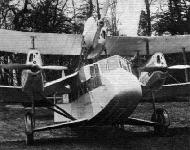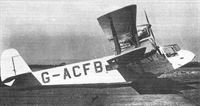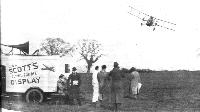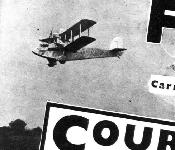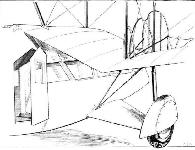
Airspeed AS.4 Ferry
Британская фирма "Airspeed Ltd" был основана в 1931 году в Портсмуте, графство Гэмпшир. Одним из первых директоров компании был сэр Алан Кобхэм, который поставил себе задачу популяризировать среди британцев гражданскую авиацию. Одним из способов достижения этой цели была возможность позволить людям просто и относительно дешево совершить короткий ознакомительный полет, испытав на себе воздушное путешествие. Показы Алана Кобхэма (известные как "воздушный цирк") проводились в Британии в летние месяцы 1932-1936 годов. Демонстрационные полеты оказались очень эффективной рекламой авиаперевозок - по уверениям организаторов, за тот период на самолетах Кобхэма прокатилось около миллиона пассажиров.
Для таких полетов требовалась небольшая многомоторная пассажирская машина, и Кобхэм поручил фирме "Airspeed" спроектировать и построить два подходящих самолета, получивших обозначение Airspeed AS.4, а позднее название Ferry (Паром). Они стали первыми самолетами, построенными фирмой. Компоновка этих машин была довольно необычной - они были выполнены по бипланной схеме с нижним крылом, имевшим сильный излом. Два из трех двигателей располагались в гондолах на стыке центроплана и консолей нижнего крыла, а третий размещался по центру передней кромки верхнего крыла. Такая компоновка обеспечивала пилоту хороший обзор вперед. Объемный фюзеляж прямоугольного сечения вмещал 10 пассажиров. К нему крепилось хвостовое оперение, усиленное подкосами и шасси. Конструктивные элементы самолета были деревянными, фюзеляж обшит фанерой, а крылья - полотном. Моторы были разного типа - на верхнем крыле стоял de Havilland Gipsy III в перевернутом положении, а на нижнем - Gipsy II с обычным положением цилиндров. Облет прототипа, состоявшийся 5 апреля 1932 года, прошел успешно, и вскоре за первой последовала вторая машина. В течение первого года коммерческой эксплуатации эти два самолета перевезли приблизительно 92 000 пассажиров. В дальнейшем построили еще две такие машины, которые достались только что созданной авиакомпании "Midland and Scottish Air Ferries".
ТАКТИКО-ТЕХНИЧЕСКИЕ ХАРАКТЕРИСТИКИ
Airspeed AS.4 Ferry
Тип: 10-местный пассажирский самолет
Силовая установка: три рядных мотора de Havilland Gipsy II/III, взлетной мощностью по 120 л. с. (89 кВт)
Летные характеристики: максимальная скорость на уровне моря 174 км/ч; крейсерская скорость 137 км/ч на высоте 305 м; максимальная скороподъемность на уровне моря 158 м/мин; время набора высоты 3050 м - 38 минут; потолок 3960 м; дальность полета 515 км
Массы: пустого 1560 кг; максимальная взлетная 2540 кг; максимальная полезная нагрузка 680 кг
Размеры: размах крыла 16,76 м; длина 12,09 м; высота 4,34 м; площадь крыла 59,55 мг.
Описание:
- Airspeed AS.4 Ferry
- Flight, April 1932
The Airspeed "Ferry" - Flight, November 1932
British Aircraft
Фотографии
-
Мировая Авиация 20
Регистрационный номер: G-ABSI [22] Характерной особенностью самолета Airspeed AS.4 было нижнее крыло с большим изломом, крепившееся к верхней части фюзеляжа.
-
Aeroplane Monthly 1989-08 / Personal album. Civil
Регистрационный номер: G-ABSI [22] Airspeed A.S.4 Ferry G-ABSI, probably snapped at Cardiff on September 25, 1935 at the end of its final season with Cobham's National Aviation Day Displays. It flew with Scott's Air Display the following year. On the outbreak of war the Ferry was impressed into RAF service as AV968.
-
Flight 1932-04 / Flight
Регистрационный номер: G-ABSI [22] THE "FERRY": Unusual Features are the placing of the central engine, the raising of the lower plane wing roots, and the winglet enclosing the axles and radius rods.
-
Aeroplane Monthly 1987-08 / J.Stroud - Wings of Peace
Регистрационный номер: G-ABSI [22] This view of the first Airspeed Ferry clearly shows the unusual wing and engine layout.
-
Aeroplane Monthly 1987-08 / J.Stroud - Wings of Peace
Регистрационный номер: G-ABSI [22] The first Ferry, G-ABSI Youth of Britain II, photographed at Hanworth Air Park in May 1932.
-
Flight 1932-04 / Flight
Регистрационный номер: G-ABSI [22] "YOUTH OF BRITAIN II": The first Airspeed "Ferry" poses for its portrait at Hanworth. This machine, which was described in "Flight" of April 15, is a ten-seater to be used by Sir Alan Cobham on his tour of Great Britain. The engines are two Gipsy II's and one Gipsy III.
-
Flight 1933-08 / Flight
Регистрационный номер: G-ABSI [22] Airspeed "Ferry" (2 "Gipsy III" and 1 "Gipsy II") ten seater.
-
Мировая Авиация 141
Регистрационный номер: G-ABSI [22] "Летающий цирк" Алана Кобхэма появлялся едва ли не в каждом уголке Великобритании. На фотографии - Airspeed Ferry готовится к очередному полету, запланированному на следующий день.
-
Aeroplane Monthly 1990-12 / Personal album. Civil
Регистрационный номер: G-ABSI [22] Airspeed A.S.4 Ferry prototype G-ABSI Youth of Britain II joyriding with Cobham's National Aviation Displays Ltd at Skipton on June 21, 1932. The ten-passenger wooden biplane was powered by three 120 h.p. Gipsy engines and entered service with Cobham in April 1932.
-
Aeroplane Monthly 1987-08 / J.Stroud - Wings of Peace
Регистрационный номер: G-ACFB [3] Midland & Scottish Air Ferries' second Airspeed Ferry, G-ACFB, at Liverpool.
-
Air Enthusiast 2000-11 / G.Warner - Founding Fathers (2)
Регистрационный номер: G-ACFB [3] Liverpool and the Isle of Man were linked for the first time by Airspeed Ferry G-ACFB.
-
Aeroplane Monthly 1994-02 / B.Elliott - Above, the law (1)
Регистрационный номер: G-ACFB [3] Airspeed A.S.4 Ferry G-ACFB, one of two operated by Midland & Scottish Air Ferries. Liverpool City police made use of one of them in 1934.
-
Aeroplane Monthly 1987-08 / J.Stroud - Wings of Peace
Регистрационный номер: G-ABSJ [2] National Aviation Day Display's second Ferry, G-ABSJ Youth of Britain III, later renamed Youth of Africa. In September 1934 'SJ was sold in India as VT-AFO.
-
Aeroplane Monthly 1986-05 / F.Bullmore - Circus Pilot (1)
Регистрационный номер: G-ABSI [22] The prototype Airspeed Ferry, delivered to Cobham for the 1932 tour. Named Youth of Britain II, ’SI was joined by a second Ferry, G-ABSJ, later that year.
-
Aeroplane Monthly 1976-12 / B.Williams - On tour with Cobham's Circus
Регистрационный номер: G-ABSI [22] Re-fuelling the "Airspeed Ferry" G-ABSI with National Benzole Mixture, a standard fuel equally suitable for aircraft engines or motor cars. Its passenger seats already replenished.
-
Aeroplane Monthly 1987-08 / J.Stroud - Wings of Peace
Регистрационный номер: G-ABSI [22] Ferry G-ABSI after being re-engined with de Havilland Gipsy Majors.
-
Flight 1936-04 / Flight
The Fleet: Miss Joan Meakin's Wolf glider, the Airspeed Ferry, and the B.A.C. Drone are in the foreground.
Другие самолёты на фотографии: Goppingen Go.1 Wolf - Германия - 1935Kronfeld Drone - Великобритания - 1932
-
Aeroplane Monthly 1987-08 / J.Stroud - Wings of Peace
Регистрационный номер: G-ABSI [22] The general layout of the Ferry is well shown in this view of G-ABSI.
-
Flight 1936-04 / Flight
Spring in the Air: Capt. King in the act of giving everyone a close-up of the Airspeed Ferry. One of the smart vans attached to the display is in the foreground.
-
Aeroplane Monthly 1998-09 / A.Welch - A Different World (1)
Регистрационный номер: G-ABSI [22] In 1932 the author was treated to a flight in Airspeed Ferry G-ABSI Youth of Britain when Sir Alan Cobham’s National Aviation Day Display visited Cornwall while she was holidaying there.
-
Aeroplane Monthly 1987-08 / J.Stroud - Wings of Peace
Регистрационный номер: G-ABSI [22] Many joyriders in the Airspeed Ferries were given a low-level pass in front of the crowd.
-
Flight 1933-08 / Flight Advertisements
Регистрационный номер: G-ABSJ [2] Ferry 360 h.p. Carries 10-12 passengers and pilot
-
Aeroplane Monthly 1986-03 / H.Morris - The Barnstormer's Apprentice (5)
Регистрационный номер: G-ABSI [22] The National Aviation Day display invariably opened with a Grand Flypast. This one consisted of, from top to bottom: de Havilland D.H.82 Tiger Moth G-ABUL; D.H.83 Fox Moth Youth of Newfoundland; Airspeed Ferry G-ABSI; Handley Page Clive G-ABYX Youth of Australia; Cierva C.19 Autogiro G-ABGB; Airspeed Ferry G-ABSJ; Fox Moth G-ACEX Youth of Ireland and Tiger Moth G-ACEZ.
Другие самолёты на фотографии: Cierva/Avro C.19 - Великобритания - 1929De Havilland Fox Moth / D.H.83 - Великобритания - 1932De Havilland Tiger Moth / D.H.82 - Великобритания - 1931Handley Page Hyderabad/H.P.24 / Hinaidi/H.P.33 / Clive/H.P.35 - Великобритания - 1923
-
Aeroplane Monthly 1986-06 / F.Bullmore - Circus Pilot (2)
Регистрационный номер: G-ABSI [22] The Handley Page Clive G-ABYX leads the three Avro Cadets (G-ACLU, G-ACOZ and G-ACPB), Tiger Moth G-ACEZ and Ferry G-ABSI during the Grand Formation Flypast at Dagenham on April 14, 1934.
Другие самолёты на фотографии: Avro Club Cadet / Type 638/639/640 - Великобритания - 1933De Havilland Tiger Moth / D.H.82 - Великобритания - 1931Handley Page Hyderabad/H.P.24 / Hinaidi/H.P.33 / Clive/H.P.35 - Великобритания - 1923
-
Aeroplane Monthly 1976-12 / B.Williams - On tour with Cobham's Circus
Регистрационный номер: G-ABSI [22] The circus comes to yet another town. In this formation, led by H.P. W.10 G-ABMR, are two Gipsy Moths, Comper Swift, Desoutter, Tiger Moth, Airspeed Ferry and a Southern Martlet.
Другие самолёты на фотографии: Comper Swift / CLA.7 - Великобритания - 1930De Havilland Gipsy Moth / Moth X - Великобритания - 1928De Havilland Tiger Moth / D.H.82 - Великобритания - 1931Handley Page H.P.18 (W.8) / H.P.30 (W.10) - Великобритания - 1919Koolhoven FK-41 - Нидерланды - 1928Southern Martlet - Великобритания - 1929
-
Aeroplane Monthly 1987-08 / J.Stroud - Wings of Peace
Регистрационный номер: G-ABSI [22] Part of a National Aviation Day formation: left to right, the Airspeed Ferry G-ABSI, D.H. Tiger Moth G-ACEZ and Handley Page Clive G-ABYX.
Другие самолёты на фотографии: De Havilland Tiger Moth / D.H.82 - Великобритания - 1931Handley Page Hyderabad/H.P.24 / Hinaidi/H.P.33 / Clive/H.P.35 - Великобритания - 1923
-
Aeroplane Monthly 1986-02 / H.Morris - The Barnstormer's Apprentice (4)
Регистрационный номер: G-ABSI [22] Alan Cobham's National Aviation Day display team hits town, led by an Airspeed Ferry flanked by Tiger Moths, Desoutters, a Gipsy Moth and an Avro 504K.
Другие самолёты на фотографии: Avro Avro 504 - Великобритания - 1913De Havilland Gipsy Moth / Moth X - Великобритания - 1928De Havilland Tiger Moth / D.H.82 - Великобритания - 1931Koolhoven FK-41 - Нидерланды - 1928
-
Aeroplane Monthly 1986-02 / H.Morris - The Barnstormer's Apprentice (4)
Регистрационный номер: G-ABSI [22] Cobham's Handley Page Clive G-ABYX about to touch down with an Airspeed Ferry in close pursuit. Half a dozen joyriding customers watch with nervous anticipation!
Другие самолёты на фотографии: Handley Page Hyderabad/H.P.24 / Hinaidi/H.P.33 / Clive/H.P.35 - Великобритания - 1923
-
Aeroplane Monthly 1987-08 / J.Stroud - Wings of Peace
Регистрационный номер: G-ABSI [22] THE LATEST PASSENGER-CARRIER: The cabin of the Airspeed "Ferry" has seats for 10 passengers, who all get an excellent view.
The cabin and pilot's position in Ferry G-ABSI. -
Aeroplane Monthly 1987-08 / J.Stroud - Wings of Peace
Регистрационный номер: G-ACBT KEITH WOODCOCK'S painting shows G-ACBT, Midland & Scottish Air Ferries' first Ferry, which had no raised centre-section fuel tank.
-
Aeroplane Monthly 1988-12 / P.Masefield - Wren
Wren's first contribution to C. G. Grey's The Aeroplane was published in the issue for June 22, 1933. It was titled: Identification made easy - a caricaturist’s memories of the prominent characteristics of some popular aeroplanes.
Другие самолёты на фотографии: Armstrong Whitworth Atlas / Ajax - Великобритания - 1925Avro Avro 504 - Великобритания - 1913Blackburn Bluebird / L.1 - Великобритания - 1924Blackburn Iris / R.B.1 - Великобритания - 1926Bristol Bulldog - Великобритания - 1927Cierva/Avro C.30A / Rota - Великобритания - 1932Comper Swift / CLA.7 - Великобритания - 1930De Havilland Gipsy Moth / Moth X - Великобритания - 1928De Havilland Puss Moth / D.H.80 - Великобритания - 1929Fairey Fairey IIIF - Великобритания - 1926Handley Page H.P.42 / H.P.45 - Великобритания - 1930Handley Page Hyderabad/H.P.24 / Hinaidi/H.P.33 / Clive/H.P.35 - Великобритания - 1923Hawker Fury - Великобритания - 1931Klemm L.25 - L.28 Swallow - Германия - 1927Supermarine Southampton / Solent - Великобритания - 1925Vickers Jockey / Type 151 - Великобритания - 1930Vickers Virginia - Великобритания - 1922Westland Wapiti - Великобритания - 1927Westland Widgeon - Великобритания - 1924
-
Flight 1932-04 / Flight
NOVEL FEATURES: The lower plane roots are raised to the top longerons. A winglet encloses the wheel axle and radius rod, and is hinged to the fuselage. The cabin door arrangement, the wing engine mounting, and the "spats" over the wheels are other features illustrated.
-
Flight 1932-04 / Flight
The details of the raised lower wing root are illustrated in this sketch. The spars as well as the compression member are of box section. The wing engine is carried on bearers projecting forward from the front spar.
-
Flight 1932-04 / Flight
A.S.4 2 Gipsy II & 1 Gipsy III Engines.
- Фотографии





